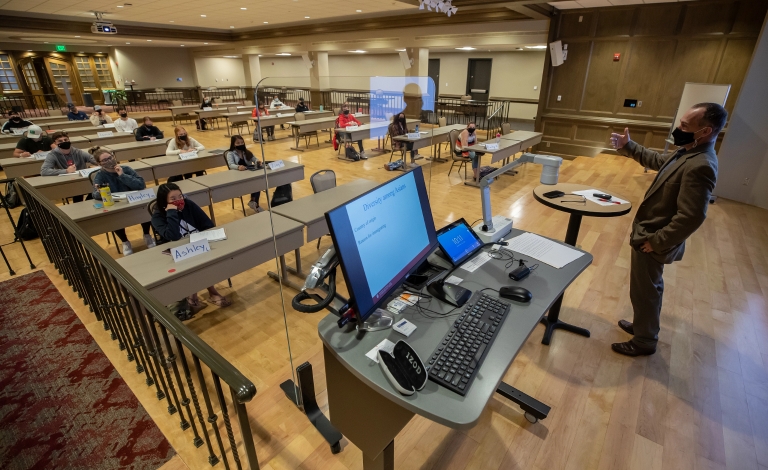
BLOOMINGTON, Ind. – As Indiana University concludes its final planned week of in-person instruction for the fall semester, IU researchers have analyzed data from the university’s semester-long COVID-19 testing program and found that infection risk was not higher among students attending more in-person courses.
The study reviewed data from more than 70,000 undergraduate students at all IU campuses and compared the number of positive tests with the number of in-person credit hours taken by the students.
“What we found is that, actually, the more in-person credit hours a student had, the less likely they were to test positive for COVID-19,” said Dr. Lana Dbeibo, assistant professor of clinical medicine and medical director of infection prevention at the IU School of Medicine, and a key member of the IU Medical Response Team. “This analysis gives us even more confidence that the safety measures IU put in place in order to resume in-person instruction – in addition to the diligence of our students, faculty and staff following public health guidance throughout the semester – have been effective.”
Molly Rosenberg, assistant professor of epidemiology at the IU School of Public Health-Bloomington, and core member of IU’s Mitigation Testing team, conducted this analysis with Dbeibo and the Medical Response Team.
“The idea here is that if IU classrooms were risky for COVID-19 transmission, we’d expect to see higher numbers of cases among students who spend more time in classrooms,” Rosenberg said. “It would be what we call a ‘dose-response’ relationship. In fact, we saw the opposite trend.”
Dbeibo said that for each in-person credit hour taken above zero, students were increasingly less likely to test positive for COVID-19 in the fall semester. For students taking one to three in-person credit hours, the proportion of the population who tested positive for COVID-19 over the semester was 8 percent. The lowest proportion of students testing positive for COVID-19 were those taking 13 to 15 in-person credit hours; only 2 percent of students in this group tested positive.
“Coming into this semester, we didn’t know exactly what to expect. We knew we had sound public health guidance and safety practices in place, but everything was untested given that this was a new situation for all of us,” Dbeibo said. “We were ecstatic to see this data and are so pleased we’ve been able to offer our students in-person classes safely for 13 weeks as planned.”
In addition to the safety protocols put in place in classrooms, including distancing, mask wearing and enhanced cleaning, IU also implemented a robust asymptomatic testing program. The university’s mitigation testing began as classes started in August and provided asymptomatic testing to a large sample of students, faculty and staff each week. Data from mitigation testing, as well as symptomatic testing, is reported weekly on the university’s public dashboard.
Beginning after the Thanksgiving holiday, IU’s courses will be all online through early February. Students will finish the fall semester online, can opt to take additional online courses during a new winter session and then will begin the spring semester online on Jan. 19 before coming back to campus in early February. Mitigation testing, however, will continue for those still coming to campus during the time when courses are online this winter.
Dbeibo, Rosenberg and the Medical Response Team plan to continue analyzing data over the winter and into the spring semester to spot any trends and ensure that the plans in place continue to keep IU students, faculty and staff as safe as possible.

